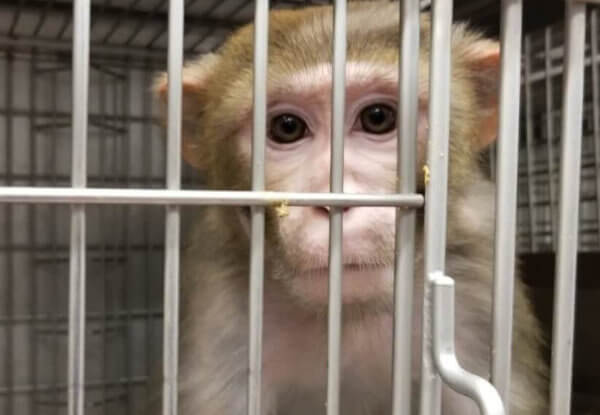Toxic and Tragic: Testing on Animals
Every year, more than 115 million animals—including mice, rats, frogs, dogs, cats, rabbits, monkeys, and more—are used in laboratories all over the world. Animals used for household-product and cosmetics testing and medical experiments are forced to endure terrifying and painful procedures and deprived of everything that’s natural and important to them. These thinking, feeling individuals are treated like nothing more than disposable laboratory equipment.
Product Testing: A Deadly Dose
Despite the existence of alternative non-animal testing methods, companies continue to poison and kill animals in crude tests that were developed as long ago as the 1920s. In these tests, rats, mice, guinea pigs, rabbits, and other animals are forced to swallow or inhale massive quantities of a test substance or endure the pain of having a chemical eat away at their sensitive eyes or skin—even though the results are often unreliable or not applicable to humans. And even if a product has blinded an animal, it can still be marketed to you.
Tests are performed on animals to evaluate the toxicity of consumer products and their ingredients, despite the significant anatomical and physiological differences between humans and animals. These archaic and fatal tests—including a World War I–era lethal dose 50 percent (LD50) test, which even today remains the most common form of animal-poisoning study—have never been scientifically validated to confirm their relevance to humans.
A Change in China
Previously, the Chinese government required tests on animals before cosmetics products could be marketed in the country. With the help of PETA’s funding and scientific expertise, China is making strides in moving away from animal testing and has approved its first non-animal test for cosmetics. In June 2014, cosmetics companies that produced and sold their products in China were given the option to market their products without first testing them on animals. The country’s long-standing animal-testing requirement has now ended, and most companies can make their own decisions about whether or not they test on animals.
While China still requires tests on animals for all cosmetics imported into the country, allowing Chinese companies to opt out of animal testing is a step in the right direction that could prevent countless animals from being poisoned and killed each year. This paves the way for non-animal tests to become more readily accepted.
PETA Asia and PETA U.S. are working toward the day when the Chinese government will not only end its animal-testing requirements for cosmetics but also ban these cruel methods, as the European Union, Israel, and India have already done.
Bad Medicine: Medical Experiments
Every year, millions of animals endure painful, frightening procedures at the hands of experimenters. Animals used for experiments are burned, shocked, poisoned, isolated, starved, addicted to drugs, and brain damaged. They are immobilized in restraint devices for hours, have holes drilled into their skulls, have their skin burned off, or have their spinal cords crushed. Despite the existence of superior non-animal tests, many scientific institutions are still failing to move forward and embrace the cutting-edge, non-animal technologies that have the potential to save countless human and animal lives.
The role that animal experimentation plays in most medical advances is questionable. Deadly diseases artificially induced in animals can never replicate those that happen naturally in humans. Animals are biologically different on so many significant levels, making it even more unlikely that these experiments will provide us with productive and reliable results for humans. As scientist Dr. Richard Klausner has said, “We have cured mice of cancer for decades, and it simply didn’t work in humans.”
Animal experimenters want us to believe that if they give up their archaic habit, medicine would stop progressing all together. That’s simply not the case. Studies published in prestigious medical journals have shown time and again that animal experimenters are often wasting lives—both animal and human—by trying to infect animals with diseases that they would never normally contract.
The non-animal tests available today are humane, cheaper, and more accurate at predicting human reactions to a product than animal tests ever were. More and more companies are switching to these methods as consumer support for cruelty-free products grows.
What You Can Do
Go cruelty-free! The best way to stop companies, universities, and charities from using animals is to refuse to purchase their products or give them donations. Write to tell them that they won’t receive your support until they stop testing on animals.
Take a stand against animal testing by pledging to support only cruelty-free companies and charities. You can find out which of your favorite products are animal-friendly by searching PETA U.S.’ online database of companies that do and that don’t test on animals, and you can see which charities conduct humane research at HumaneSeal.org










